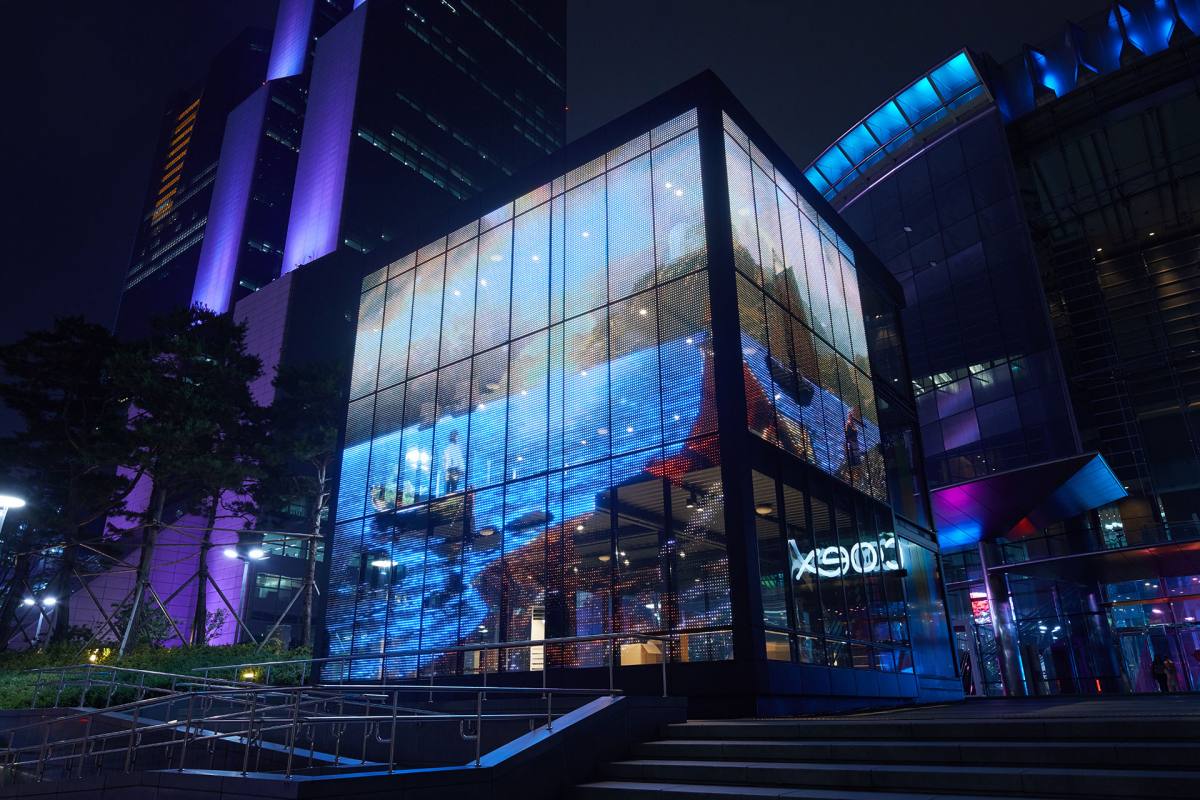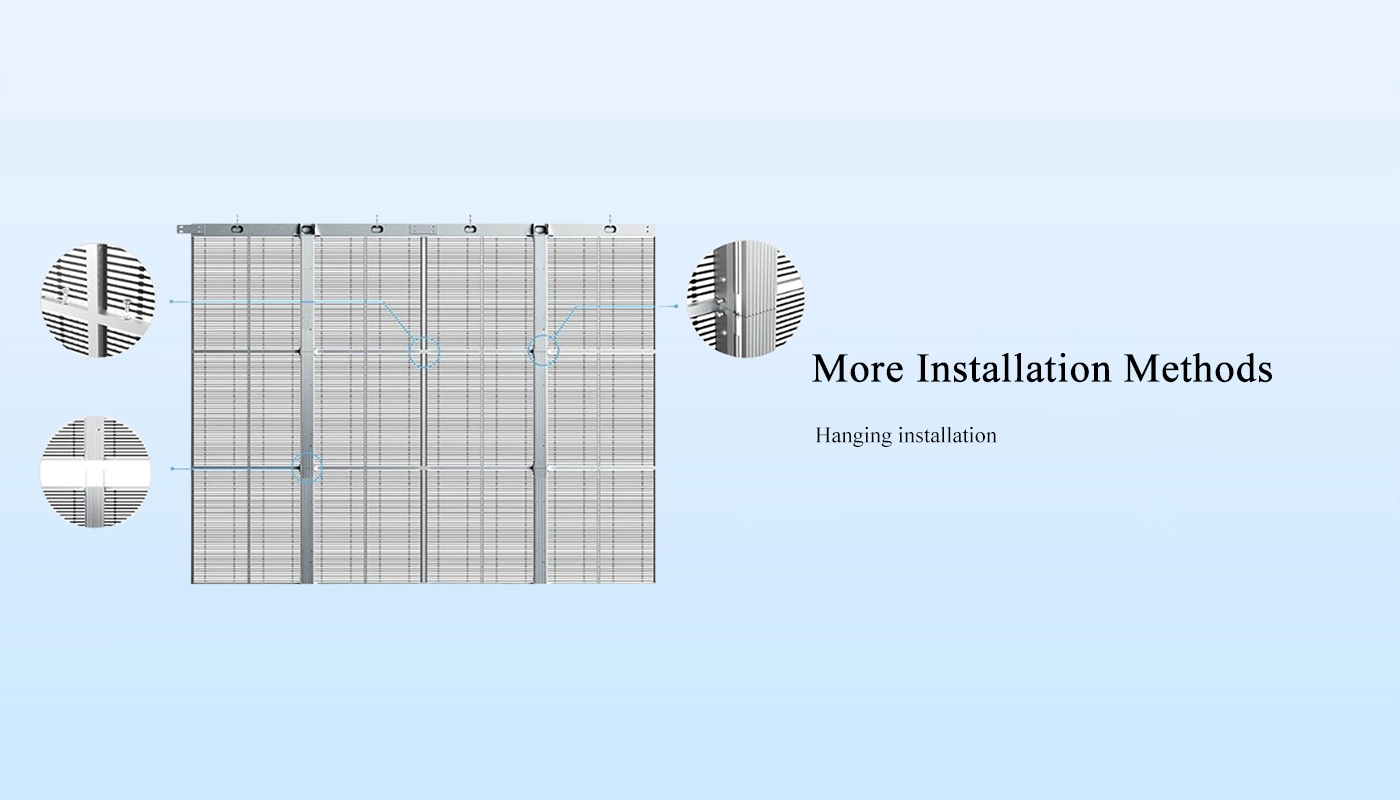Natural Light Matters in Modern Architecture
In modern architecture, transparency and openness are more than trends—they are design principles. Architects prioritize natural light to improve energy efficiency, mental well-being, and aesthetics. Sin embargo, businesses also need large visual surfaces to convey advertising messages. This creates a conflict: how can buildings display digital content without blocking windows?
The answer lies in transparent LED displays—a revolutionary display solution that delivers both visual communication and daylight preservation. These advanced panels allow light to pass through while maintaining bright, dynamic content playback. Como resultado, they offer a seamless blend of function and aesthetics.
1. What Are Transparent LED Displays?
Transparent LED displays are digital signage solutions made with ultra-thin LED strips, spaced strategically to allow light penetration. Unlike traditional LED panels, which are solid and opaque, transparent models maintain high transparency rates—up to 90%.
These displays are often installed behind glass surfaces, such as building facades, mall windows, or showroom walls. Their thin, lightweight structure makes them ideal for high-visibility environments where design and openness matter.
Más importante aún, transparent LED displays offer high brightness, amplios ángulos de visión, and sufficient resolution for indoor and semi-outdoor applications. They are quickly becoming essential tools for modern businesses that want to communicate without compromising architecture.
2. Why Traditional Screens Create Blockages
Traditional LED panels, while visually powerful, are bulky and opaque. Installing them over glass blocks sunlight, reduces visibility from inside, and alters the building’s aesthetic. These consequences are especially problematic for:
- Retail stores relying on natural light to showcase products
- Office buildings seeking energy-efficient daylighting
- Architectural spaces where transparency is critical
Due to their solid structure, traditional panels also add weight and require structural reinforcements, making them unsuitable for curtain walls or fragile glass facades.
This is where transparent LED displays offer an elegant solution—preserving design integrity while adding digital function.
3. How Transparent LED Screens Preserve Natural Light
Transparent screens work by placing LED strips on a clear substrate, leaving gaps between pixels. These gaps allow light to flow through. During operation, the human eye naturally focuses on the content displayed, while the gaps become virtually invisible.
This effect enables buildings to:
- Retain outside visibility
- Let in full-spectrum natural light
- Eliminate claustrophobic interiors
- Maintain architectural consistency
De este modo, transparent LED displays provide both digital engagement and daylight retention.
4. Key Features That Support Design and Function
a. High Transparency Ratio
Most transparent LED displays offer 60–90% transparency, allowing maximum daylight usage.
b. Slim Profile and Lightweight
These displays often measure under 10mm thick and weigh less than 10kg/m², reducing load on glass walls.
do. Easy Installation Behind Glass
With minimal structural impact, they can be affixed using adhesive strips or brackets behind windows.
d. Weather-Resistant Options
For outdoor-facing applications, IP65-rated models withstand wind, rain, and UV radiation.
e. Eficiencia Energética
Transparent LEDs consume less energy than backlit LCDs or traditional opaque LED screens.
These features make transparent LED displays suitable for almost any glass surface application.
5. Use Cases Across Commercial Industries
Transparent LED screens are not limited to one field. They serve a wide range of industries that require visual marketing but want to preserve building openness.
Minorista: Storefronts display promotions without covering the interior view.
Corporate Offices: Lobby walls and facades display branding while keeping interiors bright.
Aeropuerto & Estaciones: Dynamic information screens without blocking daylight.
Museums & Galleries: Display content without disturbing the aesthetic of glass walls.
Automotive Showrooms: Present car specs while allowing passersby to see inside.
These applications prove how transparent LED displays harmonize modern design and smart communication.
6. Digital Impact Without the Bulk
Transparent LED displays offer visual richness without overwhelming the viewer. Their see-through design gives the content a “floating” apariencia, enhancing engagement without obstructing architectural clarity.
Unlike conventional signs that impose themselves on the environment, transparent LEDs blend into it. This subtle integration creates digital canvases that feel part of the building, not an addition to it.
Además, brands can deliver messages at high brightness—visible even under sunlight—without sacrificing transparency.
7. Maintenance and Long-Term Benefits
From a technical perspective, transparent displays are easier to maintain due to their modular nature. Faulty modules can be replaced without dismantling the entire screen.
Además, their long LED lifespan (50,000+ horas) and low energy usage ensure a lower total cost of ownership. Businesses investing in transparent LED displays often recoup costs through higher foot traffic, brand exposure, and energy savings.
8. Trends Shaping the Future of Transparent Displays
As LED technology advances, expect more innovations in this space. These include:
Micro-LED transparency for ultra-high-resolution indoor use
Touch-interactive transparent screens for retail experiences
Glass-integrated LEDs, where displays are embedded into the building material
AI-driven content adaptation, where displays adjust visuals based on ambient light
Such trends suggest that transparent LED displays will play a pivotal role in future smart buildings.
Conclusión: Transparency Without Compromise
In a world that demands both function and form, transparent LED displays offer the perfect balance. They allow buildings to breathe, light to enter, and brands to communicate—all without compromise.
Whether you’re designing a flagship store, corporate HQ, or exhibition center, these displays offer unmatched benefits. They are not just tools for digital signage—they are part of the architecture itself.
With transparent displays, we no longer have to choose between visibility and light. Now, we can have both.




